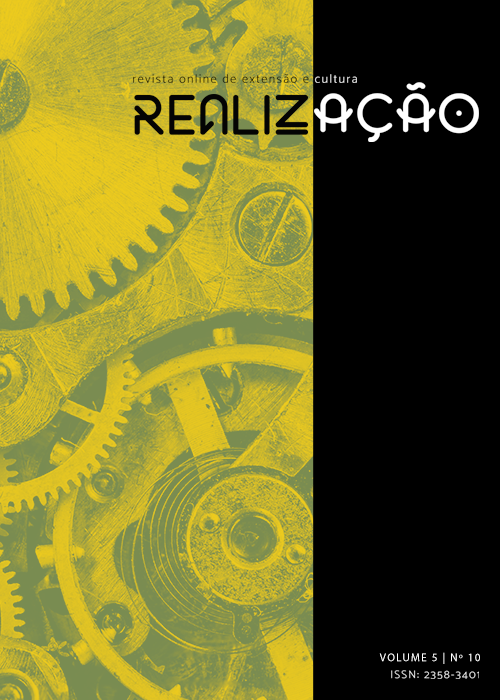Gravimetric characterization of solid waste before and after the "adopt a mug" program at an administrative establishment in the municipality of Iguatemi/MS
DOI:
https://doi.org/10.30612/re-ufgd.v5i10.8615Keywords:
Gravimetry , Solid waste , CompostingAbstract
After the implementation of the National Solid Waste Policy (PNRS), established by Federal Law No. 12,305/2010, public and private institutions, together with society, became part of the solid waste management chain, being mandatory to correctly dispose of all waste generated in their activities so that the disposal has minimal impact on the environment. The objective of this study was to perform the analysis of the gravimetric composition of solid waste generated in a restaurant, located in the city of Iguatemi, in the state of Mato Grosso do Sul. For this purpose, the waste generated in the establishment was collected for 06 days (from Monday to Saturday) and then the weighing and gravimetric composition of the waste was carried out. It was observed that the restaurant generates 79.10 kg of waste per week, of which 65.30 kg is organic matter, 6.80 kg is aluminum, 3.45 kg is paper, 2.15 kg is PET packaging, 0.75 kg is plastic, and 0.65 kg is bottle caps. Of the total waste, approximately 80% is wet waste (organic material) and 20% is dry waste (other materials). After analyzing the activities at the site and the current disposal of waste, one of the most viable solutions would be to raise awareness among the employees of this establishment about the importance of separating solid waste, initially prioritizing binary separation between dry and wet waste, with the purpose of facilitating the collection and final disposal of the same, as well as the composting of organic material.
Downloads
References
ARAÚJO, N. C.; QUEIROZ, A. J. P.; GUIMARÃES, P. L. F.; GOMES, A. A. Gravimetria e abordagem econômica dos resíduos sólidos urbanos do município de Barra do São Miguel - Paraíba. Revista eletrônica em gestão, educação e tecnologia ambiental, Santa Maria. v. 19, n. 3, p. 67-72, 2015.
BESEN, G. R.; GÜNTHER, W. M. R.; RODRIGUES, A.; BRASIL, A. L . Resíduos sólidos: vulnerabilidades e perspectivas. In: SALDIVA P. et al. Meio ambiente e saúde: o desafio das metrópoles. São Paulo: ExLibris. 2010.
BRASIL. Lei 12.305 de 2 de agosto de 2010. Institui a Política Nacional de Resíduos Sólidos; altera a Lei no 9.605, de 12 de fevereiro de 1998; e dá outras providências.
IBGE - Instituto Brasileiro de Geografia e Estatística. Mato Grosso do Sul, Iguatemi. 2016. Disponível em: < http://cidades.ibge.gov.br/xtras/perfil.php?codmun=500430>. Acesso em: 02 jun 2017.
MONTEIRO, J.H.P., FIGUEIREDO, A.F.; MAGALHÃES, A.F.; MELO, M.A.F.; BRITO, J.C.X.; ALMEIDA, T.P.F.; MANSUR, G.L. Manual de Gerenciamento Integrado de Resíduos Sólidos. Rio de Janeiro: IBAM. 204p. 2001.
OLIVEIRA, M. V. C.; CARVALHO, A. R. Princípios básicos do saneamento do meio. SENAC. 1997.
PINHEIRO, T. B.; BARBOSA, D. M.; GOMES, F. S.; GONÇALVES, F. Y.; ARAÚJO, L. R.; RESENDE, T. M. Caracterização dos resíduos sólidos de um restaurante comercial em Patos de Minas, MG. Revista CENAR, Patos de Minas. v. 1, n. 1, 2015.
SECRETARIA DE ESTADO DE MEIO AMBIENTE, DO PLANEJAMENTO, DA CIÊNCIA E TECNOLOGIA. Plano Estadual de Resíduos Sólidos de Mato Grosso do Sul (PERS-MS). Campo Grande, MS, p. 47, 2014.
Downloads
Published
How to Cite
Issue
Section
License
Copyright (c) 2018 João Vitor Corrêa Gonçalves

This work is licensed under a Creative Commons Attribution-NonCommercial-ShareAlike 4.0 International License.
Autores que publicam nesta revista aceitam as normas de publicação, bem como, concordam com os seguintes termos:
(a) O Conselho Editorial se reserva ao direito de efetuar, nos originais, alterações da Língua portuguesa para se manter o padrão culto da língua, respeitando, porém, o estilo dos autores.
(b) Autores mantêm os direitos autorais e concedem à revista o direito de primeira publicação, com o trabalho simultaneamente licenciado sob a Creative Commons Atribuição-NãoComercial-CompartilhaIgual 4.0 Internacional que permite: Compartilhar — copiar e redistribuir o material em qualquer suporte ou formato e Adaptar — remixar, transformar, e criar a partir do material. A Creative Commons Atribuição-NãoComercial-CompartilhaIgual 4.0 Internacional considera os termos seguintes:
- Atribuição — Você deve dar o crédito apropriado, prover um link para a licença e indicar se mudanças foram feitas. Você deve fazê-lo em qualquer circunstância razoável, mas de nenhuma maneira que sugira que o licenciante apoia você ou o seu uso.
- NãoComercial — Você não pode usar o material para fins comerciais.
- CompartilhaIgual — Se você remixar, transformar, ou criar a partir do material, tem de distribuir as suas contribuições sob a mesma licença que o original.
- Sem restrições adicionais — Você não pode aplicar termos jurídicos ou medidas de caráter tecnológico que restrinjam legalmente outros de fazerem algo que a licença permita.


